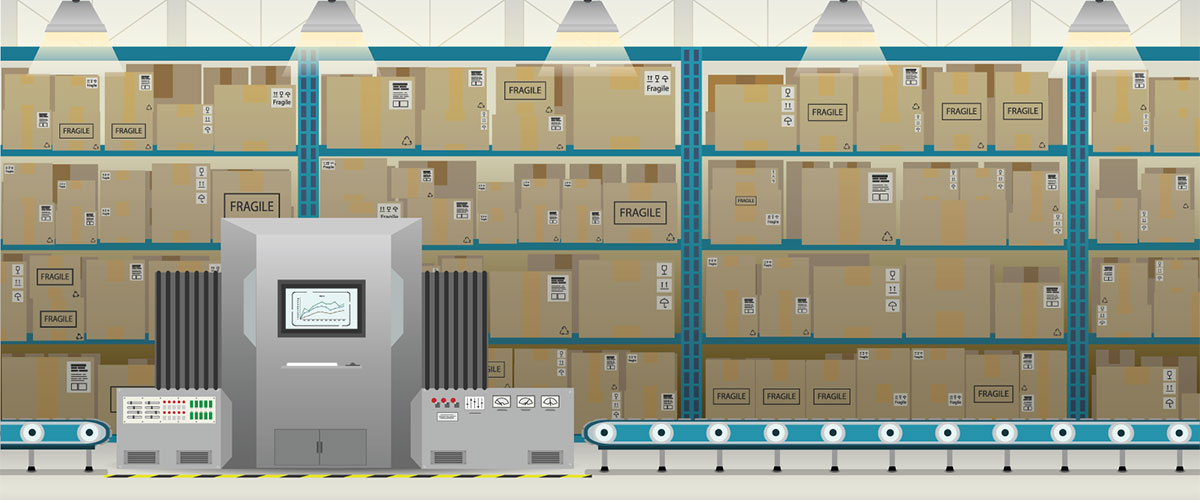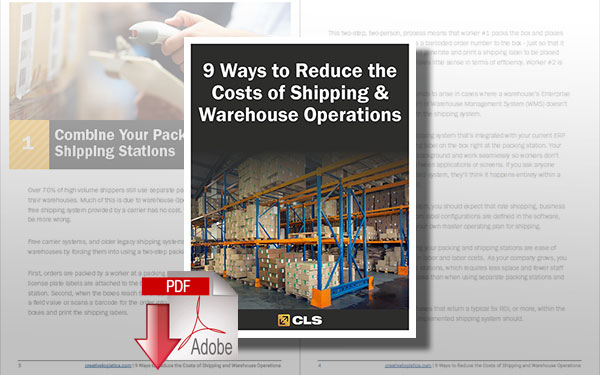Four Proven Ways to Reduce Shipping Costs

Streamline workflow and improve productivity in the warehouse through multi-carrier shipping software, integrated pack/ship stations, data collection solutions and more.
Looking For Ways to Reduce Shipping Costs?
In addition to negotiating to get the best possible rates from your carriers and tracking your packages to identify late delivery refunds, here are five cost-saving insights we’ve gained from decades of working with clients of all sizes and across multiple industries.
The best part about these savings is that they can deliver bottom-line dollars (a.k.a. your profit dollars).
You may incur some upfront hardware and software costs related to implementing a new shipping software solution, but the system improvements and cost savings you’ll gain by optimizing your shipping methods and correcting fulfillment issues should generate savings in the first year, and for many years to come.
1. Combine Your Packing and Shipping Stations
Over 70% of high-volume shippers still use separate packing and shipping stations in their warehouses. Much of this is due to warehouse operations staff thinking that a free shipping system provided by a carrier has no cost. The reality is that they couldn’t be more wrong.
Free carrier systems, and older legacy shipping systems, have impacted many warehouse operations by forcing them into using a two-step packing and shipping process.
- First, orders are packed at the packing station by a worker who attaches a packing list and license plate labels to the boxes and sends them over to a shipping station
- The shipping station worker keys in or scans a barcoded order data into the shipping software to process the shipment and print the shipping labels.
This two-step, two-person, process means that worker #1 packs the box and places a license plate label or attaches a barcoded order number to the box, just so that it can be sent to worker #2 who will generate and print a shipping label to be placed on the box. This configuration is inefficient. Worker #2 is redundant.
This redundancy also tends to arise when the warehouse ERP and WMS systems aren’t integrated to share data in real-time with the shipping system.
Suggestion: Replace standalone carrier-provided systems with a centralized multi-carrier shipping system integrated for real-time communications with your ERP or WMS. This approach makes it possible to produce the shipping label on the box right at the packing station.
Your shipping solution can be configured to run in the background so workers don’t have to spend time changing between applications or screens. In fact, anyone who works this way thinks it happens entirely within a single solution (the ERP or WMS).
With a multi-carrier shipping system, you should expect that rate shopping, business rules, logos on labels, and custom label configurations are defined in the warehouse software, and each should be specific to your own master operating plan for shipping.
Very few purchases that return a typical 5X ROI, or more, within five years. A properly implemented shipping system should.
Benefits: A 5X ROI is not unusual when combined pack/ship stations are implemented, due to enhanced ease of use and a significant reduction in labor and labor-related costs. As your company grows, you simply add additional pack/ship stations, which require less space and fewer than separate packing stations and shipping stations.
Related: An Integrated Packing and Shipping Station can Create Greater Efficiencies 
2. Take Advantage of Carrier Rate Shopping Software
Less than 50% of the shipping market takes advantage of rate shopping. The vast majority of companies select and rely on a primary carrier to deliver most of their packages. This is often done in the mistaken belief that “the more I ship with an individual carrier, the higher my discount will be.”
Not necessarily. In many cases, lightweight or low zone packages can actually have a negative effect on your overall discount. By shifting or shopping these packages with other carriers or services, you can improve your primary discounts and increase overall savings. Rate shopping these packages can actually save you more money than many multi-tier pricing breaks.
Less than 50% of the shipping market takes advantage of rate shopping.
Whether you’re using one or multiple standalone carrier-provided shipping systems, your organization can also lose out on logistics agility by limiting your options to delivery areas, restrict service choices, and extend delivery commitment times, all of which can negatively impact meeting the overall needs of your customers.
With multi-carrier shipping software, you can rely on the system to automatically compare various carrier rates and service levels on individual shipments. The best systems make it easy to add USPS and smaller regional carriers alongside FedEx and UPS without adding equipment for each carrier.
If you don’t rate shop, you may be losing a tremendous amount of money. For instance, packages below 6 to 8 pounds, and packages that are being dimensionally rated by your current carrier may be cheaper to ship via USPS using the Commercial Plus Rate. This is because USPS does not use dimensional rating.
Most large companies qualify for this rate, particularly if they are an e-commerce shipper.
3. Increase Your Standardized Packaging Options
Just picking a box and filling it with as much or as little product as you wanted was fine years ago when major carriers only used weight-based rating. But now that carriers have switched to broader dimensional rating over the past few years, using the wrong size box has become very expensive.
The businesses that benefit most from rate shopping are those with a variety of package sizes and weights.
Many companies may think they’re doing well in optimizing their packaging options, but it’s really hit or miss. Box size utilization is rarely checked or analyzed, even though it is vital to cost-effective shipping. With over 50 percent of the boxes I’ve audited, the shipper is using a box bigger than necessary.
For example:
- Consider a 12″ x 12″ x 12″ box. A one square foot box is 1,728 cubic inches which dimensionally weighs out to a 13-pound carrier rate for shipping.
- If you fill this 13-pound dim rated box with only 7 pounds of products, you’re potentially paying approximately $5 more to ship that box than you need to.
Packages with excess space also lead to increased void fill, increasing packing material costs and the risk of possible product damage. Shippers may need to work with their box vendors to provide a larger selection of box sizes to accommodate weight-based and dimensional shipment rating.
In more than 50% of the packaging audits we’ve conducted, shippers are using bigger boxes than are needed.
Another little-known fact is that for packages and poly-bags being shipped via USPS, the US Postal Service provides free boxes and envelopes, saving you an additional $.25 to $.75 cents per package.
Steps to Determine the Right Box Standards
Consider having a larger selection of box sizes available for fulfillment. This adds little cost compared to consistently using a few box sizes that force your shipping staff to ship orders with too much empty space.
- Look at your average order size and get a selection of boxes to match.
- Include 3 to 5 box sizes larger and 3 to 5 box sizes smaller than your average order size to handle outlier packages
Also, does your WMS system offers containerization and dimensional weight calculators? These tools can provide further cost-saving insights that may work best for your needs.
4. Eliminate Address Errors and Correction Fees with Address Verification Software
Address corrections can be expensive. In 2018, UPS raised their address correction charge by $2.50 resulting in a per-package charge of $13.40, with a maximum of $91.00 per shipment for domestic and up to $91.00 per shipment for international.
Many warehouse processes ship packages without validating addresses and ends up with 20 to 30 or more bad addresses per week. Just 20 incorrect addresses per week results in an additional and unnecessary expense of over $20,000 or more per year.
To determine how much address errors are costing your company, check your carrier invoices and take the needed steps to correct it.
We discovered that one of our clients had over $250,000 in address error fees. We corrected this quickly.
Suggestion: Implement address validation software to eliminate address errors before shipments are processed. This software is offered by many companies and is a critical part of warehouse technology. It should be implemented at the point of order, not at the point of shipping. It is essential that the person placing the order be questioned or challenged if the data is incorrect or incomplete, especially if the order is being placed on a website.
Benefit: You’ll see immediate cost savings to due preemptive address validation and correction. For example, one of our clients had over $250,000 in address error fees. They were told by their previous vendor that address validation should be done at the shipping station. The company simply didn’t want to slow down shipping production time to validate addresses.
As a result, they accepted the high address correction charges as a cost of doing business. We corrected this quickly. It’s easy to calculate their savings based on the number of address errors the new approach prevented.
CLS has worked with many companies to streamline workflow and improve productivity in the warehouse through the combination of streamlined workflows integrated with multi-carrier shipping software, integrated pack/ship stations, data collection solutions and more.
Related White Paper
9 Ways to Reduce the Costs of Shipping & Warehouse Operations
Opportunities for savings abound in the warehouse when you know what to look for; make sure that you’re getting a shipping solution to solve your shipping problems and not just a shipping system. Download Now!
Article Topics
Creative Logistics Solutions News & Resources
How to Reduce Shipping Costs with Pre-Manifesting How Much is Your Slow Shipping System Really Costing You? InfoShip®/Vx earns 2019 FedEx Compatible Solution of the Year Four Proven Ways to Reduce Shipping Costs An Integrated Packing and Shipping Station can Create Greater Efficiencies 9 Ways to Reduce the Costs of Shipping & Warehouse Operations Empowering the Growth of Dollar Shave Club with InfoShip®/Vx More Creative Logistics SolutionsLatest in Warehouse|DC
North Carolina Welcomes Amazon’s Newest Mega-Warehouse SAP Unveils New AI-Driven Supply Chain Innovations U.S. Manufacturing is Growing but Employment Not Keeping Pace Maximize Warehouse Space with Mezzanine Automation: Expert Tips Most Companies Unprepared For Supply Chain Emergency Microsoft Unveils New AI Innovations For Warehouses Spotlight Startup: Cart.com is Reimagining Logistics More Warehouse|DC














